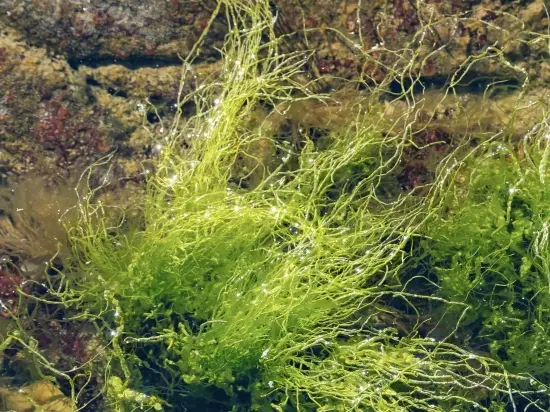
Ulva intestinalis
- Vitamin B12
- Calcium
- Magnesium
- Protein
- Iron
- Iodine
On Demand weeks


DE-ÖKO-070
EU agriculture
Typical applications: Ulva intestinalis
Typical applications
More common under the names sea lettuce, gutweed or grass kelp, Ulva intestinalis is a green alga part of the Ulva genus. This species of green algae has a yellow-green to bright or dark green colour and a intestin-like appearance, therefore its name.
Like most of the Ulva genus, this species can generally be found almost all over the world and is consumed in numerous ways by many human beings.
Due to its great variety of micro and macro nutrients, the sea grass is a nourishing source for both humans and animals. It shows a considerable amount of protein, dissolvable dietary fibers, and a range of vitamins and minerals and iron[3]. Therefore it is no suprise that Ulva is being used as an additive for animal feed[4].
It has also been suggested to use it to extract possible molecules of interest for medicine or industry, or to use it as a bioindicator species.
The powder is commonly used for food and dietary supplements.
This product is available in the following forms: Ulva intestinalis powder, Ulva intestinalis flakes and Ulva intestinalis dried raw algae. This product is also available as a non-organic variant.
Typical applications in the cosmetics industry:
Green algae Ulva intestinalis is a rich source of nutrients, proteins and peptides[6]. The extract promotes the production of collagen and hyaluronic acid by human dermal fibroblasts[3].
Ulva intestinalis has properties that are promising for the cosmetic field.
The high content of magnesium, selenium, calcium and iron, as well as the antioxidant, antibiotic, antiviral and antifungal effects provide a variety of positive effects for a better skin appearance[5, 6, 8].
The moisturizing extract from the macroalgae Ulva intestinalis relaxes and protects the skin from external influences. In addition, the epidermis is kept in good condition.
Sources:
- Ulva intestinalis - G.M. Guiry in Guiry, M.D. & Guiry, G.M. 27 January 2025. AlgaeBase. World-wide electronic publication, National University of Ireland, Galway. (https://www.algaebase.org/search/species/detail/?species_id=12904)
- Ulva intestinalis - Wikipedia (https://en.wikipedia.org/wiki/Ulva_intestinalis)
- Bodin J, Adrien A, Bodet PE, Dufour D, Baudouin S, Maugard T, Bridiau N. Ulva intestinalis Protein Extracts Promote In Vitro Collagen and Hyaluronic Acid Production by Human Dermal Fibroblasts. Molecules. 2020 Apr 30;25(9):2091. doi: 10.3390/molecules25092091. PMID: 32365755; PMCID: PMC7249168. (https://pubmed.ncbi.nlm.nih.gov/32365755/)
- Rouhani E, Safari R, Imanpour MR, Hoseinifar SH, Yazici M, El-Haroun E. Effect of Dietary Administration of Green Macroalgae (Ulva intestinalis) on Mucosal and Systemic Immune Parameters, Antioxidant Defence, and Related Gene Expression in Zebrafish (Danio rerio). Aquac Nutr. 2022 Nov 4;2022:7693468. doi: 10.1155/2022/7693468. PMID: 36860428; PMCID: PMC9973132. (https://pubmed.ncbi.nlm.nih.gov/36860428/)
- Farasat M, Khavari-Nejad RA, Nabavi SM, Namjooyan F. Antioxidant Activity, Total Phenolics and Flavonoid Contents of some Edible Green Seaweeds from Northern Coasts of the Persian Gulf. Iran J Pharm Res. 2014 Winter;13(1):163-70. PMID: 24734068; PMCID: PMC3985267. (https://pubmed.ncbi.nlm.nih.gov/24734068/)
- Sun S, Xu X, Sun X, Zhang X, Chen X, Xu N. Preparation and Identification of ACE Inhibitory Peptides from the Marine Macroalga Ulva intestinalis. Mar Drugs. 2019 Mar 19;17(3):179. doi: 10.3390/md17030179. PMID: 30893907; PMCID: PMC6471128. (https://pubmed.ncbi.nlm.nih.gov/30893907/)
- Peasura N, Laohakunjit N, Kerdchoechuen O, Vongsawasdi P, Chao LK. Assessment of biochemical and immunomodulatory activity of sulphated polysaccharides from Ulva intestinalis. Int J Biol Macromol. 2016 Oct;91:269-77. doi: 10.1016/j.ijbiomac.2016.05.062. Epub 2016 May 17. PMID: 27212215. (https://pubmed.ncbi.nlm.nih.gov/27212215/)
- Kulkarni SA, Krishnan SBB, Chandrasekhar B, Banerjee K, Sohn H, Madhavan T. Characterization of Phytochemicals in Ulva intestinalis L. and Their Action Against SARS-CoV-2 Spike Glycoprotein Receptor-Binding Domain. Front Chem. 2021 Sep 27;9:735768. doi: 10.3389/fchem.2021.735768. PMID: 34650958; PMCID: PMC8506597. (https://pubmed.ncbi.nlm.nih.gov/34650958/)

ALGANEX certificate system
Reply within twelve hours